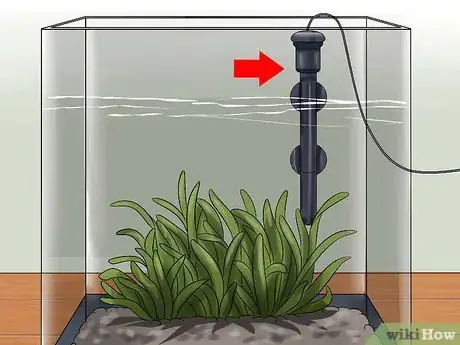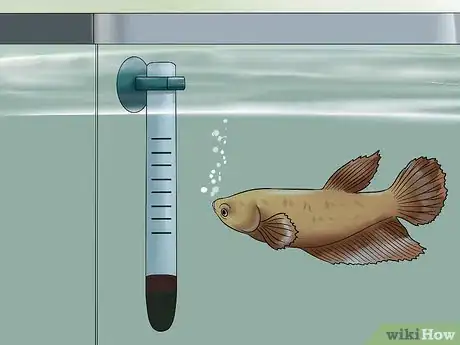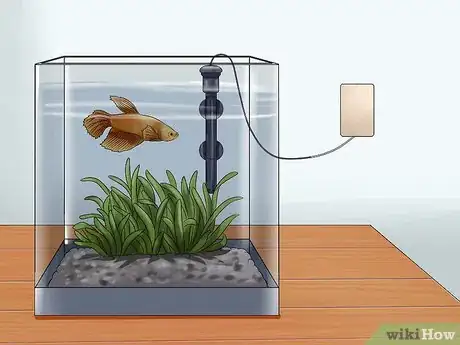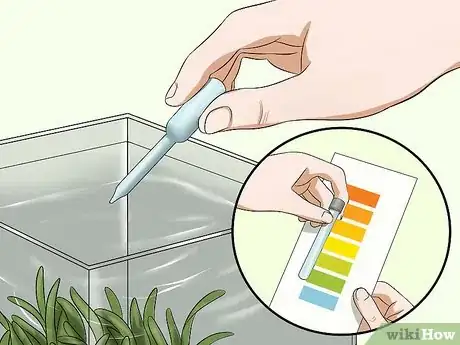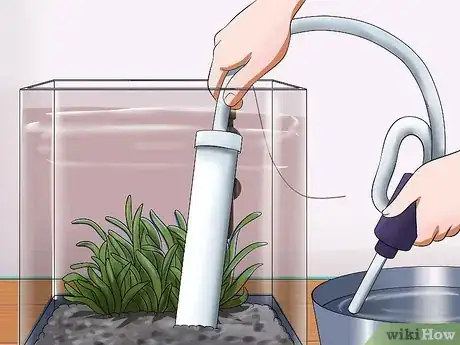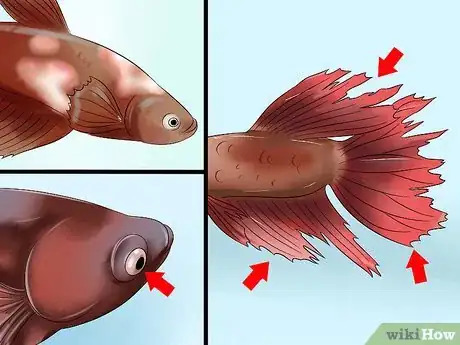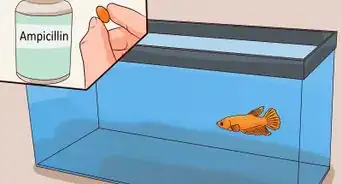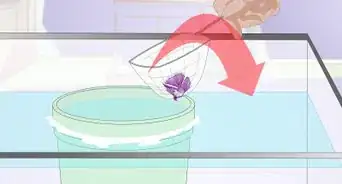This article was co-authored by Craig Morton. Craig Morton is the CEO of Aquarium Doctor Inc. based in Huntington Beach California and servicing Orange County, Los Angeles County, and the Inland Empire. With over 30 years of aquarium experience, Craig specializes in creating custom aquarium designs along with aquarium installation, service, and maintenance.
wikiHow marks an article as reader-approved once it receives enough positive feedback. In this case, 100% of readers who voted found the article helpful, earning it our reader-approved status.
This article has been viewed 185,928 times.
Keeping and caring for a Betta fish can be an enjoyable and rewarding experience. Part of providing proper care for your betta fish is maintaining the temperature of the aquarium. Betta fish are sensitive to their environment and water that is either too cold or too hot can cause health problems. Properly maintain the temperature in your aquarium to help keep your betta in good health.
Steps
Maintaining the Temperature of the Tank
-
1Install a heater in the tank. You must provide warm water to maintain the health of your betta fish. To do this, you will need to get a heater for your aquarium. The type of heater you need will vary, depending on how large your aquarium is.[1] The two main types of heaters should be available at your local pet supply store.[2]
- Tanks larger than 2.5 gallons will need a submersible aquarium heater.
- For tanks between 2.5 and 4 gallons, you will need a 25 watt power rating. For 5-10 gallon tanks, purchase a 50 watt heater.
- Tanks that are smaller than 2.5 gallons can use submersible 7.5 watt heater pads. These pads don't regulate temperature, so you will need to monitor the temperature of the tank often.
- Lamps are not the best choice for heating as betta fish do not like bright lighting.
-
2Add a thermometer to the tank. The easiest way to keep an eye on the temperature in your betta's aquarium is to install a thermometer. You will need a thermometer that is designed to be submerged into the tank water. Once your thermometer is installed you can easily check to make sure your betta is in an ideal environment.[3]
- Temperatures need to be maintained at 78 to 82 degrees Fahrenheit or 24 to 26 degrees Celsius.
- Place the thermometer in a place that you can easily read it.
- Thermometers that stick on the side of the aquarium are often not accurate enough to use.
Advertisement -
3Place the tank in a good location. Consider where the best place in your house might be for your aquarium. Look for areas that are more stable in terms of temperature, naturally helping to maintain the temperature in your tank.[4]
- Avoid placing the tank next to any drafty windows or cool areas in your house.
- Don't put the aquarium next to a heat source.
Providing the Additional Care
-
1Maintain the quality of your tank water. Beyond monitoring the temperature in your betta's aquarium, you will need to maintain other aspects of the water as well. Keep up with the following characteristics of the water in your betta's tank to help keep it healthy:[5]
- pH level can be monitored with pH strips. These can be bought at most pet stores that sell aquariums and fish. Keep tank water neutral, with a pH of 7.
- Tank water must be clean and cannot contain any chlorine. Your pet store may have dechlorination tablets available.
- If possible, let your tank water sit for 24 hours before adding it to the aquarium. This allows for gases that could potentially harm your fish to be fully released.
-
2Clean the aquarium. Regular cleaning of your betta's aquarium is a mandatory part of properly caring for your fish. How often you clean the aquarium will depend on how large your tank is.[6]
- 1 gallon tanks need to be cleaned every other day, 2.5 gallon tanks every 3-4 days, and 5 gallon tanks every 5-7 days.
- Take note of the tanks temperature. You will need to match the new water to this temperature.
- Scoop your fish out of the bowl and place it, along with some tank water, in a safe container.
- Dump all the old water out of the tank.[7]
- Scrub the tank with warm water. Clean any gravel in the tank.[8] Clean all of the decorations too. Wipe the inside of the tank down with a cloth or paper towel.
- Replace the decorations and refill the tank with clean, dechlorinated water.
- Raise the temperature of the tank up to the temperature that the old water was.
- Acclimate your fish to the bowl. Place the container with your fish in the aquarium and over the course of five minutes, add the new tank water to the container water
- After your fish has acclimated, you can release it into the tank.
-
3Monitor your betta's health. In addition to keeping track of the temperature in your fishes' aquarium, you will need to watch for signs of illness. These signs of illness can inform you if anything in your betta's tank needs attention. Look for some of the following signs of common illnesses in betta fish:
- Swim bladder disorder is indicated by any apparent difficulties your betta has swimming, including sinking, swimming sideways, or bobbing on the surface. This is usually caused by constipation but may also be caused by infection, parasite, or injury.
- Fungal infections will appear as a fuzzy, white growth on your betta. Antibiotics, a temperature of 74 degrees Fahrenheit or 23 degrees Celsius, and adding aquarium salt can help stop this.
- A disorder known as pop-eye is indicated by swollen eyes. Treat by cleaning the tank, increasing temperature to 84 degrees Fahrenheit or 28 degrees Celsius, and adding 1/8 teaspoon Epsom salt for every five gallons of water in the tank.
Expert Q&A
Did you know you can get expert answers for this article?
Unlock expert answers by supporting wikiHow
-
QuestionHow often should I change my betta's water?
 Craig MortonCraig Morton is the CEO of Aquarium Doctor Inc. based in Huntington Beach California and servicing Orange County, Los Angeles County, and the Inland Empire. With over 30 years of aquarium experience, Craig specializes in creating custom aquarium designs along with aquarium installation, service, and maintenance.
Craig MortonCraig Morton is the CEO of Aquarium Doctor Inc. based in Huntington Beach California and servicing Orange County, Los Angeles County, and the Inland Empire. With over 30 years of aquarium experience, Craig specializes in creating custom aquarium designs along with aquarium installation, service, and maintenance.
Aquarium Specialist, Aquarium Doctor Inc.
-
QuestionHow do I know if my betta has fin rot?
 Craig MortonCraig Morton is the CEO of Aquarium Doctor Inc. based in Huntington Beach California and servicing Orange County, Los Angeles County, and the Inland Empire. With over 30 years of aquarium experience, Craig specializes in creating custom aquarium designs along with aquarium installation, service, and maintenance.
Craig MortonCraig Morton is the CEO of Aquarium Doctor Inc. based in Huntington Beach California and servicing Orange County, Los Angeles County, and the Inland Empire. With over 30 years of aquarium experience, Craig specializes in creating custom aquarium designs along with aquarium installation, service, and maintenance.
Aquarium Specialist, Aquarium Doctor Inc.
-
QuestionWhat's the best kind of heater to use for my betta's tank?
 Craig MortonCraig Morton is the CEO of Aquarium Doctor Inc. based in Huntington Beach California and servicing Orange County, Los Angeles County, and the Inland Empire. With over 30 years of aquarium experience, Craig specializes in creating custom aquarium designs along with aquarium installation, service, and maintenance.
Craig MortonCraig Morton is the CEO of Aquarium Doctor Inc. based in Huntington Beach California and servicing Orange County, Los Angeles County, and the Inland Empire. With over 30 years of aquarium experience, Craig specializes in creating custom aquarium designs along with aquarium installation, service, and maintenance.
Aquarium Specialist, Aquarium Doctor Inc.
Warnings
- Putting a tank in sunlight is not a way to warm up water; algae can grow, bettas don't like it, and it'll be hard to control the temperature.⧼thumbs_response⧽
- Never put more than one male betta in your fish tank. They will fight to the death.⧼thumbs_response⧽
- Betta fish breathe by at the water's surface. Allow room in the aquarium for your betta fish to take a breath.⧼thumbs_response⧽
Things You'll Need
- A tank heater, either a small pad heater or larger tank heater, depending on tank size.
References
- ↑ Craig Morton. Aquarium Specialist, Aquarium Doctor Inc.. Expert Interview. 21 July 2020.
- ↑ http://velvetdragon.com/bettas/caresheet.html
- ↑ https://www.thatpetplace.com/articles/betta-article
- ↑ https://www.thatpetplace.com/articles/betta-article
- ↑ http://velvetdragon.com/bettas/caresheet.html
- ↑ http://velvetdragon.com/bettas/caresheet.html
- ↑ Craig Morton. Aquarium Specialist, Aquarium Doctor Inc.. Expert Interview. 21 July 2020.
- ↑ Craig Morton. Aquarium Specialist, Aquarium Doctor Inc.. Expert Interview. 21 July 2020.
About This Article
To keep a betta's water warm, you'll need to install a heater in its tank. If the tank is smaller than 2.5 gallons, you can use a submersible 7.5-watt heater pad. For a tank that's larger than 2.5 gallons, use a submersible aquarium heater between 25 and 50 watts. You should also attach a thermometer to the inside of the tank so you can monitor the water temperature, which should be kept at 76-80 degrees Fahrenheit. For more tips from our Veterinary co-author, like how to take care of your betta fish and its tank, scroll down!
